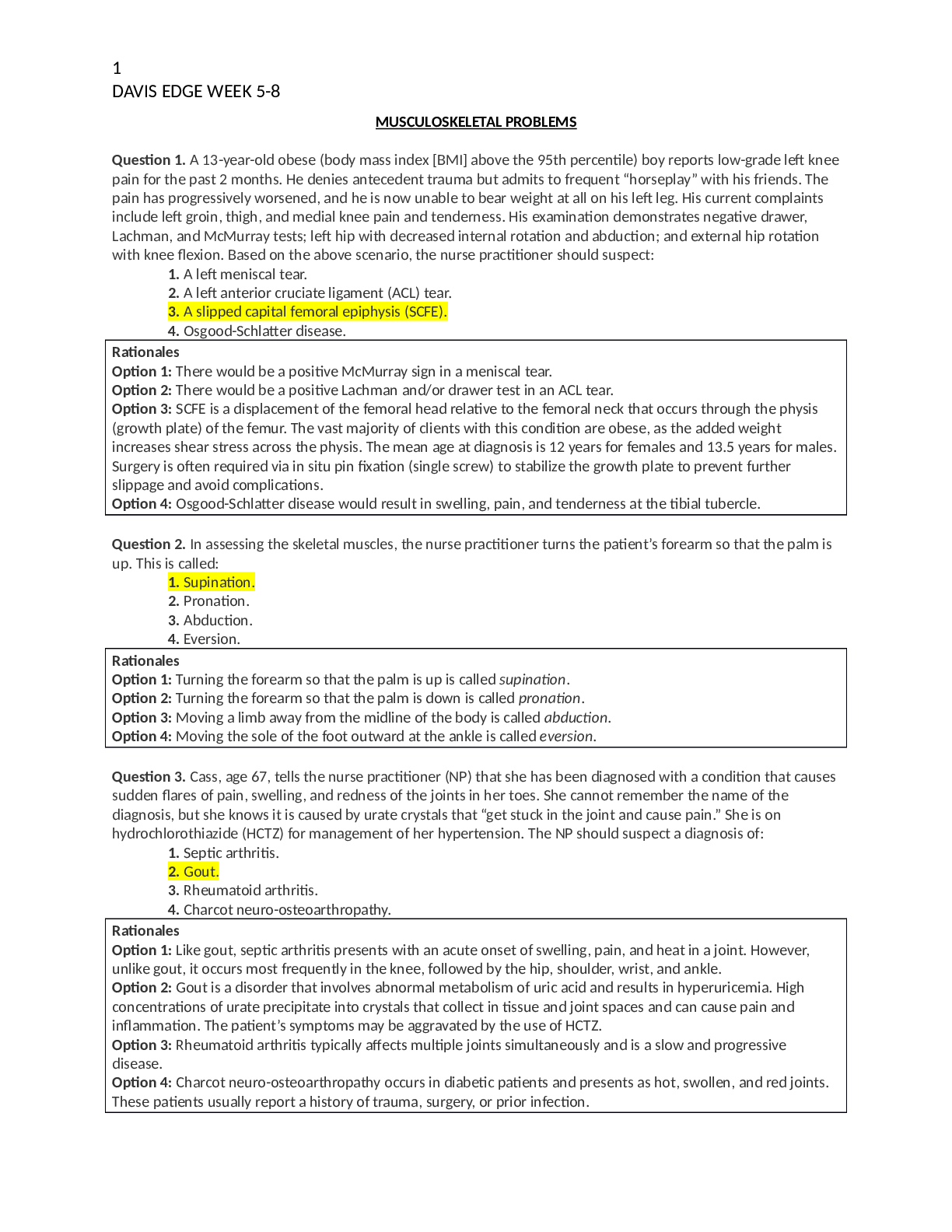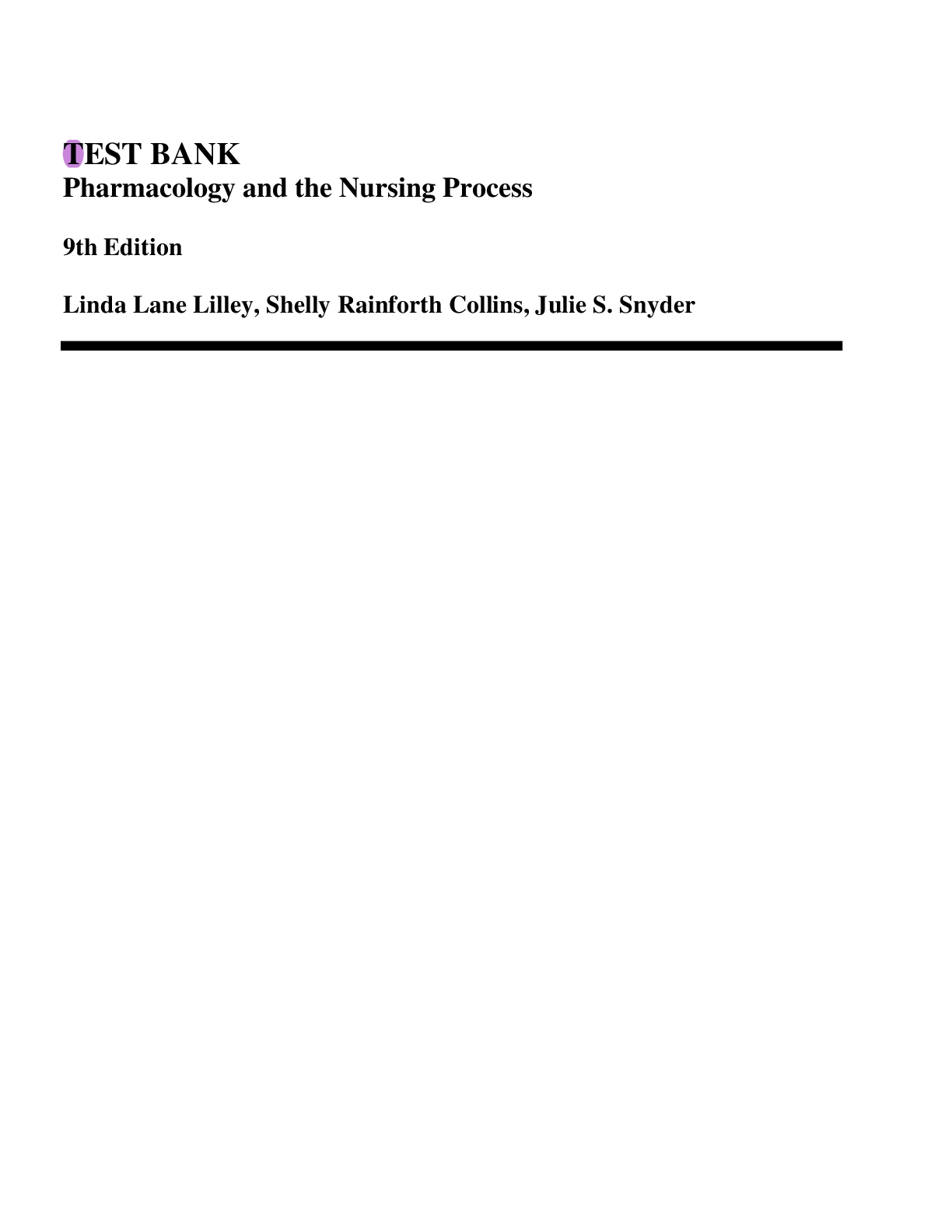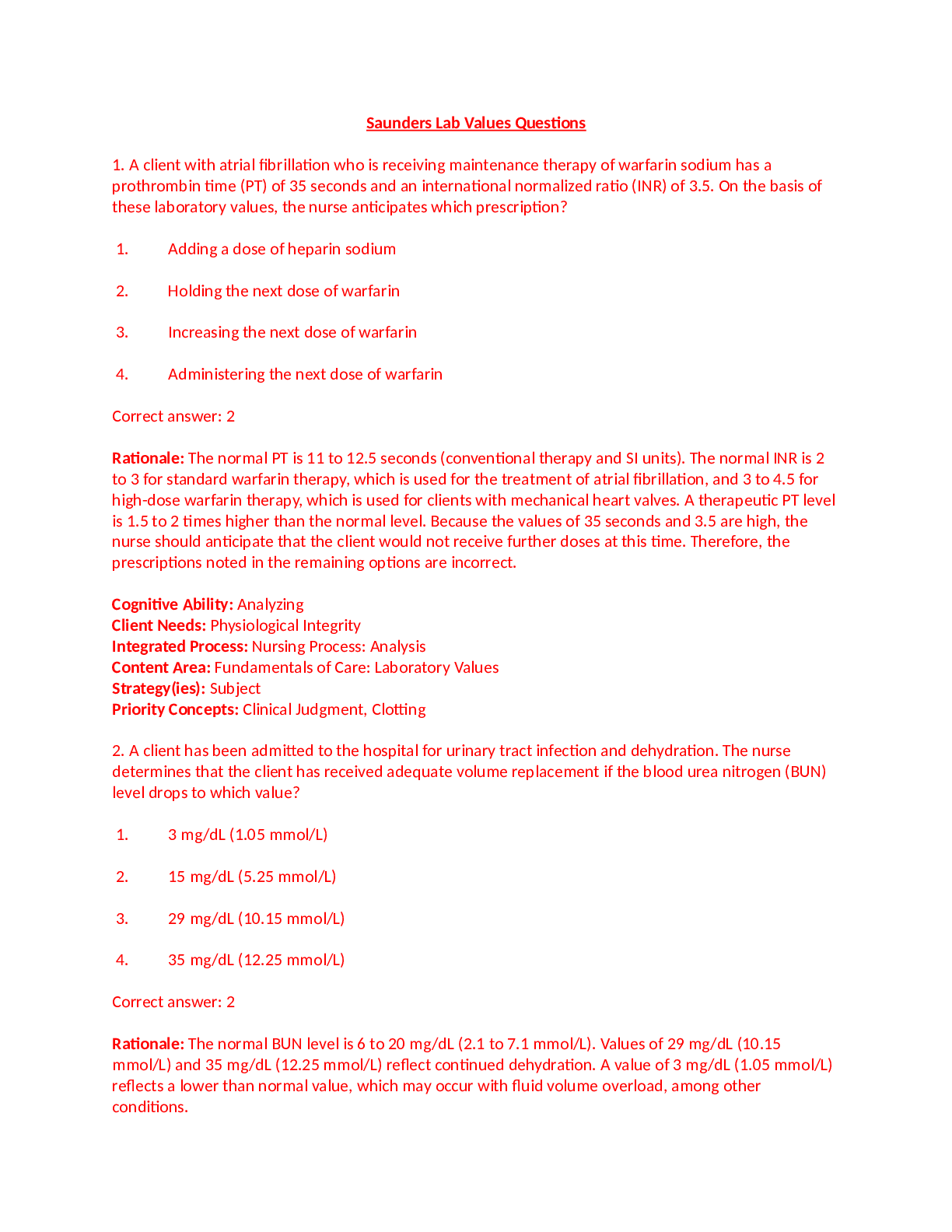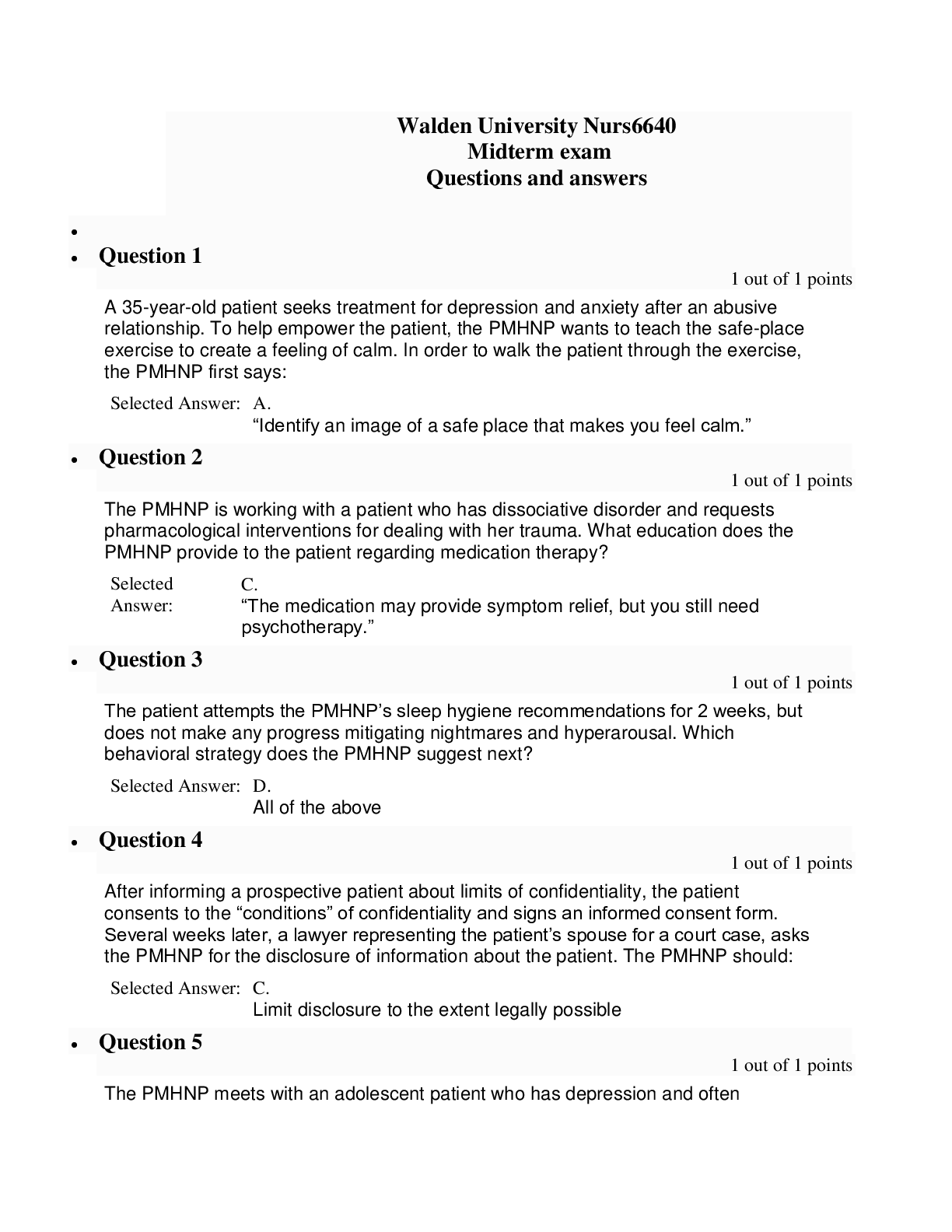Biology > QUESTIONS & ANSWERS > Prairie View A&M University - NURS 3013BIO 2302 Final Checklist. Questions, Answers and Class Notes (All)
Prairie View A&M University - NURS 3013BIO 2302 Final Checklist. Questions, Answers and Class Notes
Document Content and Description Below
Endocrine System-Ch 18 1. What is the difference between endocrine and exocrine glands? Give examples of each and be able to tell the difference between the examples in the body. 2. Explain positi... ve and negative feedback regulation and give an example of hormone(s) that use one of these methods. 3. What is the difference between hormones and neurotransmitters? Give examples of each and be able to distinguish between the two of them if asked. 4. Explain the role of receptor up-regulation and down-regulation and why each of these mechanisms of control would need to be used within the body. ➢ Receptors may be down-regulated in the presence of high concentrations of hormone 5. Explain how the pituitary gland is controlled...aka what works as the “master switch” (anterior and posterior parts). ➢ The hypothalamus secretes releasing and inhibiting hormones that control the release of hormones by the pituitary gland ➢ The anterior lobe (adenohypophysis) makes up 75% of the weight of the pituitary 6. Which hormones are released from anterior and which from posterior pituitary? ➢ Anterior ○ Adrenocorticotropic hormone (ACTH) ○ Melanocyte-stimulating hormone (MSH) ➢ Posterior 7. Be able to list and anatomically locate all the major endocrine organs of the body. ➢ Thymus → Thymosin ➢ Parathyroid Glands →Chief cells that produce parathyroid hormone (PTH) ➢ Adrenal Glands ■ Aldosterone ○ The zona fasciculata ■ Glucocorticoids ➢ Pancreas → Digestive enzymes ○ Acini ○ Pancreatic islets ➢ Ovaries ○ Estrogens ○ Progesterone 8. Deficiency of which hormone can cause diabetes? What causes Cushing’s disease? 9. Which hormone(s) boost the effects of sympathetic part of ANS? Decreases ANS? Blood-Ch 19 10. List all formed elements found in the blood. Which formed elements are technically considered “cells” and why? 11. What is measured by hematocrit? What is the normal % value for hematocrit? 12. What are “anemia” and “polycythemia” and what can cause these conditions? What value of hematocrit would indicate each of these conditions? 13. List 5 types of WBCs in the blood from most common to least common. ➢ Neutrophil 14. Which cells form from myeloid and which from lymphoid lineage in red bone marrow? ➢ Myeloid ○ RBC ○ Platelets ➢ Lymphoid ○ T-lymph 15. Which WBCs are considered “granulocytes” and which are “agranulocytes”? ➢ Granulocytes ➢ Agranular 16. Briefly explain what kind of pathogens each type of WBC fights. ➢ Neutrophil → ➢ Lymphocyte → ➢ Monocyte → ➢ Eosinophils → ➢ Basophils → 17. What are the three main steps of hemostasis? ➢ ) 18. Explain the following terms: coagulation, fibrinolysis, vascular spasm ➢ Coagulation ➢ Fibrinolysis 19. List the molecules involved in blood clotting. 20. What is the term used to describe intravascular blood clotting? Under what conditions does it occur? 21. Explain how ABO blood types work. For each blood type (A, B, AB and O) list the antigen on RBCs and the antibodies in the blood that a person will have. 22. Explain how blood typing is done and give examples. Heart and blood vessels-Ch 20/21 1. Describe the anatomical location of the heart within the chest cavity and list three layers of heart wall from outside to inside and explain from which tissues they are made of. 2. Make a diagram of a heart: label atria, ventricles, valves and blood vessels connect to heart and indicate the path of the blood flowing through these structures. 3. Which side of the heart contains oxygenated and which has deoxygenated blood? 4. Explain the functions and know the location of the following structures: papillary muscles, chordae tendineae, SA node, AV node, Purkinje fibers. 5. Briefly explain how ECG works/what it is used to test. What do the peaks and segments of ECG, such as P, QRS and T, correspond to in terms of heart cycle? List the order within the heart that a cardiac action potential travels. 6. How does pulse work and what is its normal value? What test is used to detect pulse rate? 7. Explain how heart rate and stroke volume are regulated. 8. How is blood pressure controlled? Explain the role of the following hormones in blood pressure regulation: ANP, ADH, aldosterone, renin, angiotensin and epinephrine. 9. What factors can cause heart disease (atherosclerosis)? 10. What is plethismography and what does it detect? 11. List the 3 types of blood vessels that blood goes through as it leaves the heart, before it returns back to the heart. In which type does the exchange of molecules happen? 12. Explain the location of major blood vessels of the body, such as aorta, coronary arteries, vena cava, portal vein, pulmonary arteries 13. What are the functions of anastomosis blood vessels? Where can you find them? 14. Explain how portal circulation is different from regular circulation. In which organs can you find it? Lymphatic and immune system-Ch 22 ( Daniel) 15.List the functions of the lymphatic system. 16. List the organs and structures of lymphatic system. Which are considered part of the immune and cardiovascular system? 17. Give definition of the following terms: immunity, self-tolerance, susceptibility, innate ● Immunity-The ability of an organism to resist an infection or toxin by the action of specific antibodies or sensitized white blood cells. ● Infection-The effect of a foreign organism in the body. ● Cellular Immunity-Protective immune process that involves the activation of phagocytes, antigen-sensitized cytotoxic T cells and the release of cytokines and chemokines in response to antigen. ● Immune Memory-Ability of the immune system to quickly and specifically recognize an antigen that the body has previously encountered and initiate a corresponding immune response. 18. List the body’s nonspecific defenses. What is their main function? . Physical Barriers-Intact skin and mucous membranes Inflammatory response- Chemicals cause blood vessels to leak fluid into the affected tissues, causing swelling. 19. What is the role of inflammation? What are the 4 cardinal signs of inflammation? 20. Explain the differences between innate immunity and adaptive immunity. 21. How is cellular immunity different from humoral immunity? Which one uses B-cells and which one uses T-cells? ➢ . 22. Where do B-cell and T-cells mature? 23.What is another name for activated T-cells that attack other cells? 24. What are activated B-cells called and what do they secrete? ➢ Effector cells. 25. List the 5 classes of antibodies. Which ones are made first? Which one is the main class of antibodies? ● IgG- The most abundant type of antibody, is found in all body fluids and protects ● IgA- Found in mucous membranes that line our respiratory passageway and ● IgM- Found mainly in the blood and lymph fluid, is the first antibody to be made by the body to fight a new infection. ● IgD- Exists in small amounts of the blood. ○ 26 ● . ● Respiratory system-Ch 23 50. List all the parts/organs of upper and lower respiratory tract. - The - The larynx contains the vocal folds, w •Pitch of voice sounds is •Loudness (amplitude) of means a louder sound) •Enunciation of 51. Explain how - During external respiration, c - During internal respiration, In pulmonary ventilation, List all the muscles used in respiration. Which ones are used in quiet breathing and which - diaphragm and the intercostals - Quiet breathing - Forced breathing muscles - Expiration - Inspiration 52. What is the role of compliance, - Compliance - Surface tension - Surfactant - Airway resistance 53. What ways are oxygen transported within the blood? What is the role of hemoglobin in gas transport? How does oxygen bind to hemoglobin? 54. How is carbon dioxide transported in the blood? (list all 3 ways) Digestive system and Metabolism-Ch 24/25 Alex 55. List all the regions of the GI tract in proper order from mouth to anus (i.e the path that food takes through the GI tract) 56. Name the 4 layers of a typical digestive organ, from inside to outside. Mucosa 1. Epithelium (with enteroendocrine cells spread throughout) 2. Lamina 3. Muscularis mucosaeà Submucosa Muscularis SSerosa 57. Which type of tissue is each one made of? What is the function of each? 58. What is the structure of peritoneum? (List the main parts of it) 1.Greater omentum-l 2.Falciform ligament- 3.Lesser omentum- 4.Mesentery- 5.Mesocolon- 59. Explain the functions of each part of the digestive system- specific digestive processes (chemical or mechanical digestion), what is digested and absorbed in each. 1. mouth - esophagus - 2. stomach - 3. Duodenum - 4. small intestines - 5. colon - 60. List the accessory structures of digestive system and explain briefly the function of each. 1. teeth 2. tongue - 3. salivary glands 4. liver - 5. gallbladder - 6. pancreas - 61. List the digestive enzymes secreted in each region of GI tract, indicate where they come from and what kind of molecule they digest. 1. Pepsin - 2. pancreatic amylase - 3. trypsin, chymotrypsin, carboxypeptidase, and elastase - 4. pancreatic lipase - 5. deoxy and ribonuclease - 6. brush border - 62. List the location and functions of the following cells: parietal, chief, goblet, 1. Parietal cells - 2. chief cells - st 3. goblet cells - 4. enteroendocrine - 63. What are all the functions of the liver? What is absorbed there? What digestion does it complete? 1. Contains hepatocytes that secrete bile which is necessary for emulsification of fats. 2. Metabolizes fats, carbs, and proteins 64. List all the functions of liver. ● Bile secretion and bile salt synthesis ● Bilirubin excretion ● Carbohydrate, lipid, and protein metabolism 65. What is the anatomical location and histological structure of pancreas (exocrine cells and endocrine cells) and what is its role in digestion? Which pancreatic enzymes digest what macromolecules? Why it is considered retroperitoneal? ○ pancreatic amylase - ○ trypsin, chymotrypsin, carboxypeptidase, and elastase - - digests protein ○ pancreatic lipase - ○ deoxy and ribonuclease - 66. Metabolism = catabolism + anabolism. Catabolism - breaks down molecules Anabolism - builds up molecules 67. Reduction and oxidation reactions - oxidation - reduction - 68. Briefly describe the steps of aerobic respiration (oxidation of glucose in the cell to glycolysis - cytoplasm of cell - doesn’t need oxygen - 2 ATP produced formation of Acetyl CoA - acetyl 69. Which process is used in the breakdown of fatty acids? lipid catabolism 70. How are lipids absorbed and transported in the body? List the types of lipoproteins and what each one does. Because lipids are hydrophobic they are transported by combining with proteins chylomicrons - transport dietary lipids to adipose tissue very low density lipo proteins - transport triglycerides from hepatocytes to adipocytes low density lipo proteins - carry about 75% of total cholesterol in blood and deliver to cells high density lip proteins - remove excess cholesterol from body cells and the blood and transport it to the liver for elimination 71. Explain the role of the following hormones in the metabolism regulation: insulin, insulin - stores glucose as glycogen through process called glycogenesis glucagon - thyroid hormone - cortisol - testosterone - Absorptive - Post - absorptive - energ meal - Minerals: Calcium, Phosphorus, Potassium, Sulfur, Sodium, Chloride, Magnesium, Iron, Iodide, Manganese, Copper, Cobalt, Zinc, Fluoride, Selenium, Chromium Vitamins: Fat soluble- A, D, E, K Water soluble-B1, B2, Niacin, B6, B12, Pantothenic acid, Folic acid, Biotin, C Lipolysis- Lipogenesis- Glycogenesis- Glycogenolysis Gluconeogenesis- Urinary system and fluid/electrolyte balance-Ch 26/27 72. List the anatomical parts of the urinary system ➢ Kidneys, ureters, bladder,and Urethra 73. List all functions of the kidneys ➢ Maintenance of blood osmolarity 74. Composition of urine: what are the waste products that kidney normally excretes and which molecules you will never find in urine in a healthy person? What do we evaluate in urinalysis test? ➢ You would not find Trichomas,yeast,bacteria,leukocytes(pus) ,etc in healthy person’s urine. 75. Explain the general principle of kidney function: filtration + reabsorption + secretion. 76. Name the parts of a nephron. What parts make up the renal corpuscle? What are the parts of the renal tubule (which parts of the renal tubule are not permeable to water?)? Parts of a nephron: ➢ 1. Renal Corpuscle ➢ ➢ 2. Renal Tubule ➢ Proximal Convoluted Tubule, Nephron Loop, Distal Convoluted Tubule( the part of the renal tubule that is not water permeable is the ascending limb.) ➢ . 77. What path does urine take? (nephron and move to the urethra) - Each ureter transports urine from a renal pelvis by peristaltic waves, hydrostatic pressure, 78. How is glomerular filtration regulated (include all mechanisms and cells that regulate it)? What is the equation for determining net filtration pressure? What things can and cannot pass - Glomerular filtration 79. Explain the process of formation of dilute and concentrated urine. Where does most of the reabsorption occur? - Concentrated urine - When dilute urine is formed, osmolarity in the tubule: 1. 80. Describe the process of micturition (what muscles control it, what type of reflex is it, what type of neural controls regulate it?) 81. Explain the role of each of the following hormones in kidney function specifically (which part of the nephron they work on and what do they change): ADH, ANP, angiotensin II, aldosterone, PTH. ADH: ANP: Angiotensin II: Aldosterone: PTH: 82. What is the % amount of fluid vs. solid material in human body? - 83. Give definitions of the following terms: dehydration, hyperhydration, perspiration, insensible loss of water, diuresis, natriuresis, acidosis, alkalosis, osmosis, simple diffusion, facilitated diffusion, primary active transport and secondary active transport. - dehydration: - hyperhydration: - perspiration: - insensible: - loss of water: - diuresis: - natriuresis: - acidosis: - alkalosis: - osmosis: - simple diffusion - facilitated diffusion: - primary active transport: en - secondary active transport: 84. What is the normal pH of the blood? What is measured by taking the pH level of the blood? - The normal pH blood ranges from 7.35 to 7.45. - H+ i 85. How do lungs and kidney play a role in pH regulation of the blood? (what effects do hyperventilation have on blood pH etc) 86. Explain the difference between metabolic acidosis and respiratory acidosis (do the same comparison for alkalosis) – which ions in the blood would be at different concentration in each condition? What actions cause each to happen? - Respiratory acidosis: - Respiratory alkalosis: - Metabolic acidosis: - Metabolic alkalosis: Reproductive system and development-Ch 28/29 (yanira) 87. List the structures of the reproductive systems in male and female (organs, ducts and cells). Males: ➢ Structures: Females: ➢ Ovaries, uterine tubes, uterus, vagina, external genital organs, mammary glands. 88. Briefly describe anatomy and functions of the following structures( if cells tell what they Males: testes, scrotum, dartos and cremaster muscles, tunica albuginea, seminiferous tubules, Sertoli cells, Leydig cells, epididymis, spermatic cord, vas deferens Spermatic cord ascends out of the scrotum and contains the ductus (vas) Testes Produce sperm and sex hormones Scrotum The bag of skin that contains the testes in men; keeps the testes at the proper temperature Dartos Muscles This muscle also works to regulate the temperature of the scrotum.. Cremaster Muscles cremaster muscle is found only within the male human body and covers the testis. The muscle moves the testis, promoting healthy and motile sperm. The Epididymis Site of sperm maturation; mature sperm are storage in epididymis Ductus deferens/vas deferens Paired duct for sperm maturation, storage, and transport (carries sperm from the epididymis to the ejaculatory duct); leads from the epididymis to the urethra seminiferous tubules carry sperm produced within them (spermatogenesis) Sertoli cells Sertoli cell is to control the movement of hormones, nutrients and chemicals into the seminiferous tubules. Sertoli cells secrete the following substances: ● anti-Müllerian hormone (AMH) — secreted estradiol — aromatase from Sertoli cells convert testosterone to 17 beta estradiol to direct spermatogenesis Leydig cells Secrete testosterone Females: ovary, uterus (discuss all layers), ovarian follicles (list all stages), vagina Ovary The ovary is needed in reproduction since it is responsible for producing the female Uterus The function of the uterus is to accept the fertilized ovum which will turn into a fetus and Ovarian Follicle Ovarian follicles store female egg cells and Vagina This Hollow muscular female organ leads from the uterus to the vestibule ● Functions as an organ of sexual intercourse; receives penis during sexual intercourse ● Serves as birth canal ● Serves as an exit for menstrual flow 89. For the following hormones: testosterone, Males: GnRH (gonadotropic releasing hormone), Males: FSH( follicle stimulating hormone), Males: LH (luteinizing hormone), Males: Testosterone Males: Males: Female: 90. Describe the structure of the mammary gland: alveoli, lobules, mammary ducts. 91. What are the roles of hormones prolactin and oxytocin in lactation? 92. What are the functions of the following anatomical structures: placenta, amnion, amniotic fluid, allantois, yolk sack, chorion, umbilical cord, chorionic villi? ➢ Placenta : ➢ Amnion: ➢ Amniotic fluid: ➢ Allantois: ➢ Yolk sack: ➢ Chorionic Villi: 93. List the stages of embryonic development ( Secondary oocyte -> zygote -> embryo -> fetus -> baby • Fertilization- • Zygote • Cleavage- Embryonic Period (from fertilization to 8th week) o Gastrulation o Neurulation o 3 germ layers are now in place: endoderm, mesoderm, and ectoderm • Week 4 o Development of primary brain vesicles—forebrain (prosencephalon), midbrain (mesencephalon), and hindbrain (rhombencephalon) o All major organs develop (organogenesis) between week 4 and week 8 o Embryonic folding- flat embryo folds into a 3D cylinder. • Fetal Period (from 9th week till 38th week/birth) 94. What is “decidua” and what role does it play? 100. Define: allele- genotype- phenotype- Inheritance dominant traits- recessive traits- [Show More]
Last updated: 1 year ago
Preview 1 out of 36 pages
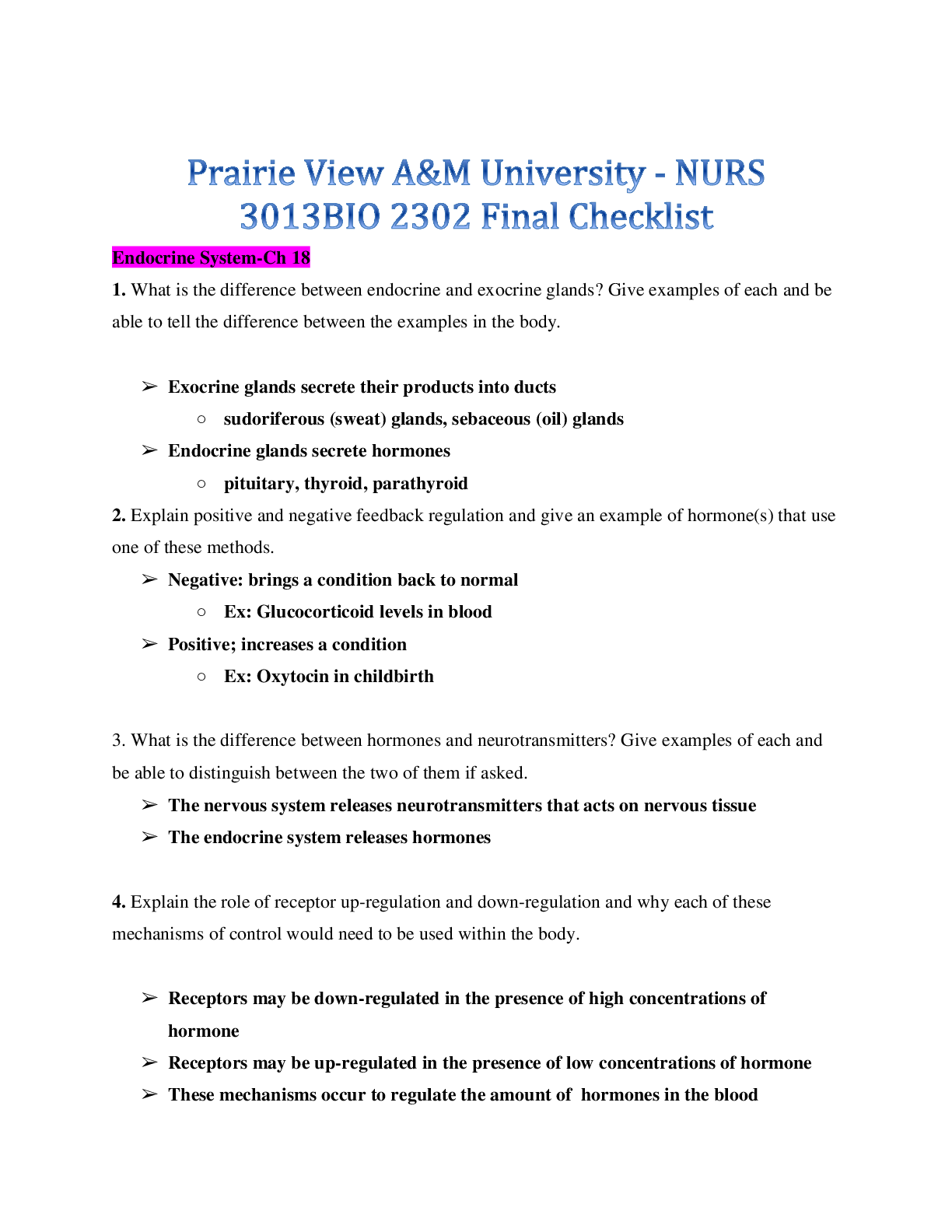
Reviews( 0 )
Document information
Connected school, study & course
About the document
Uploaded On
May 19, 2020
Number of pages
36
Written in
Additional information
This document has been written for:
Uploaded
May 19, 2020
Downloads
0
Views
47















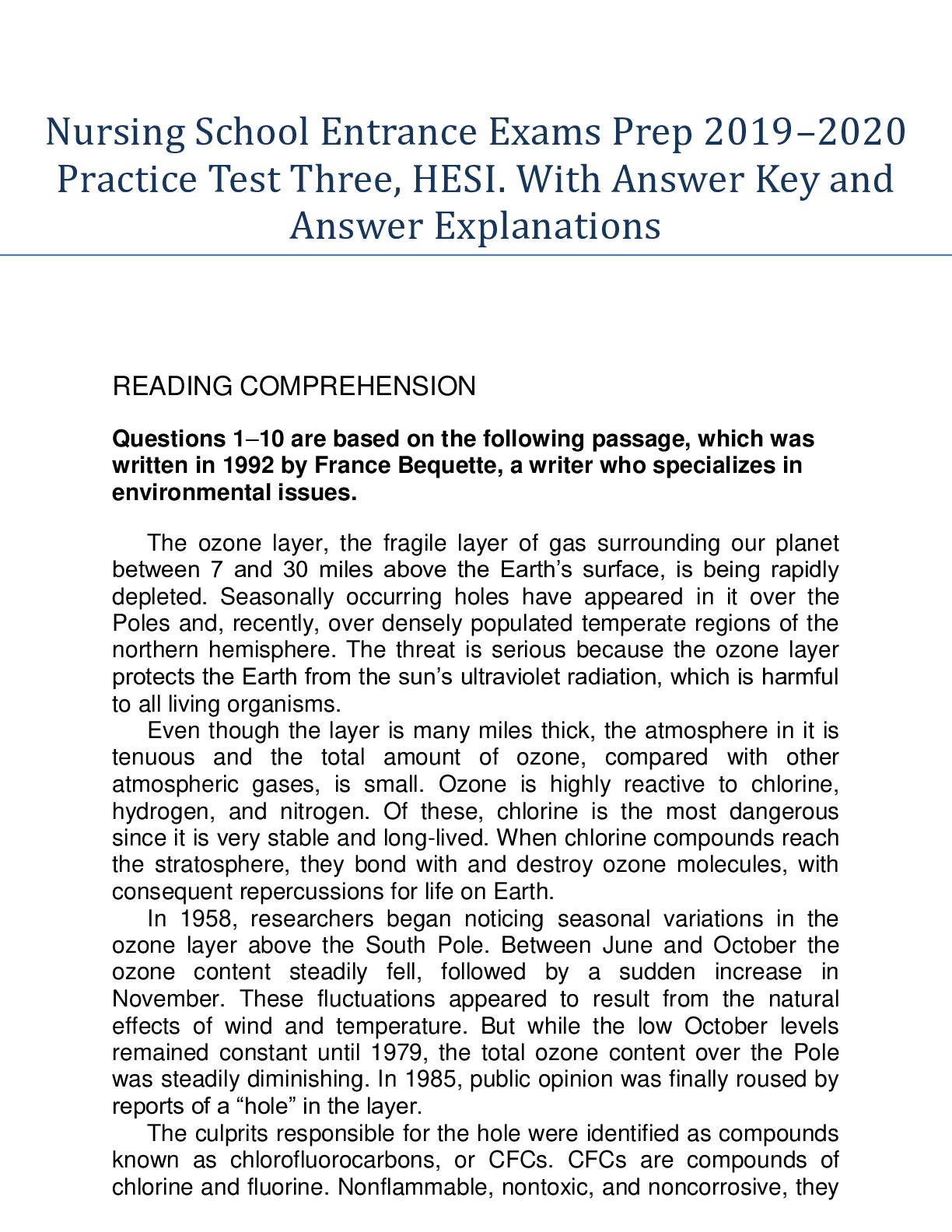

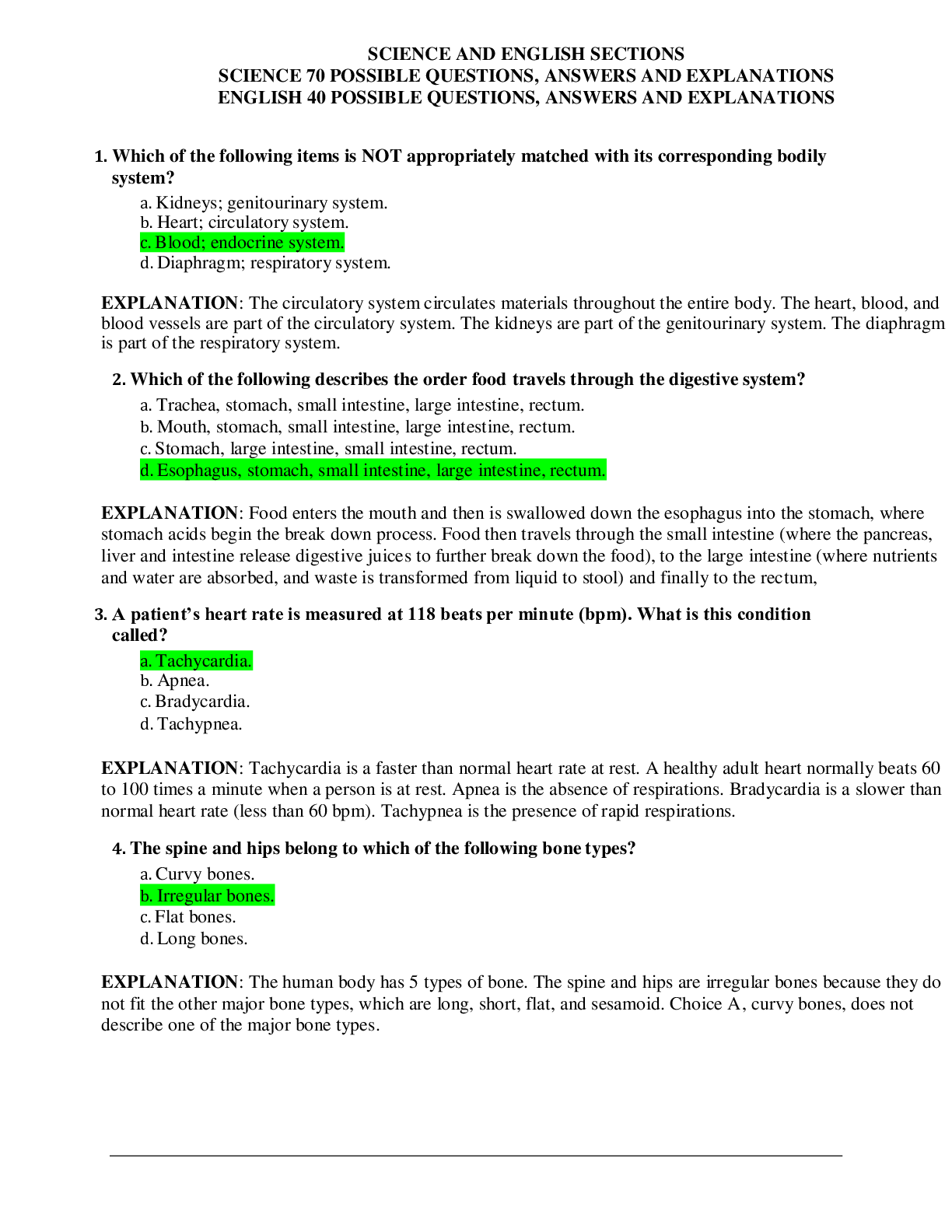
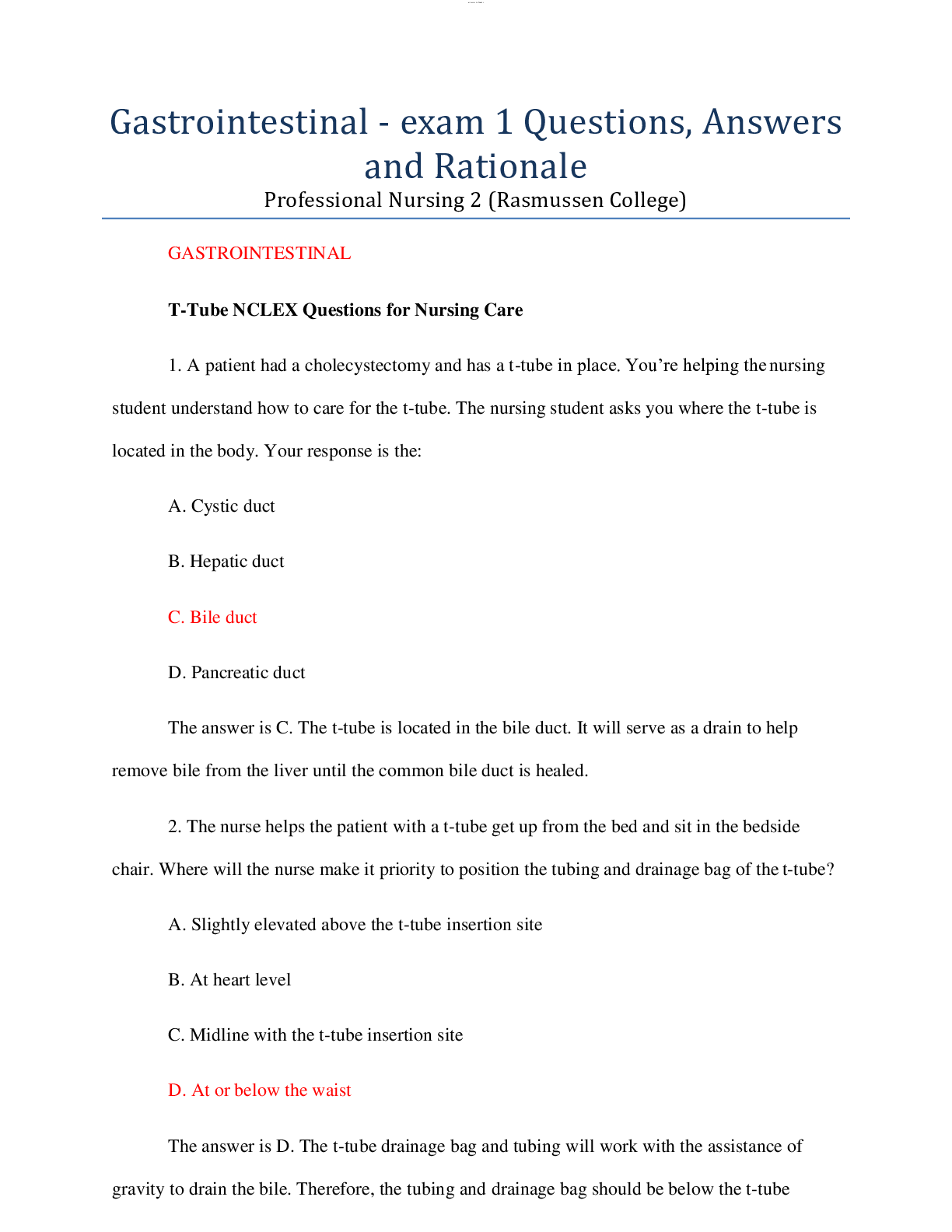
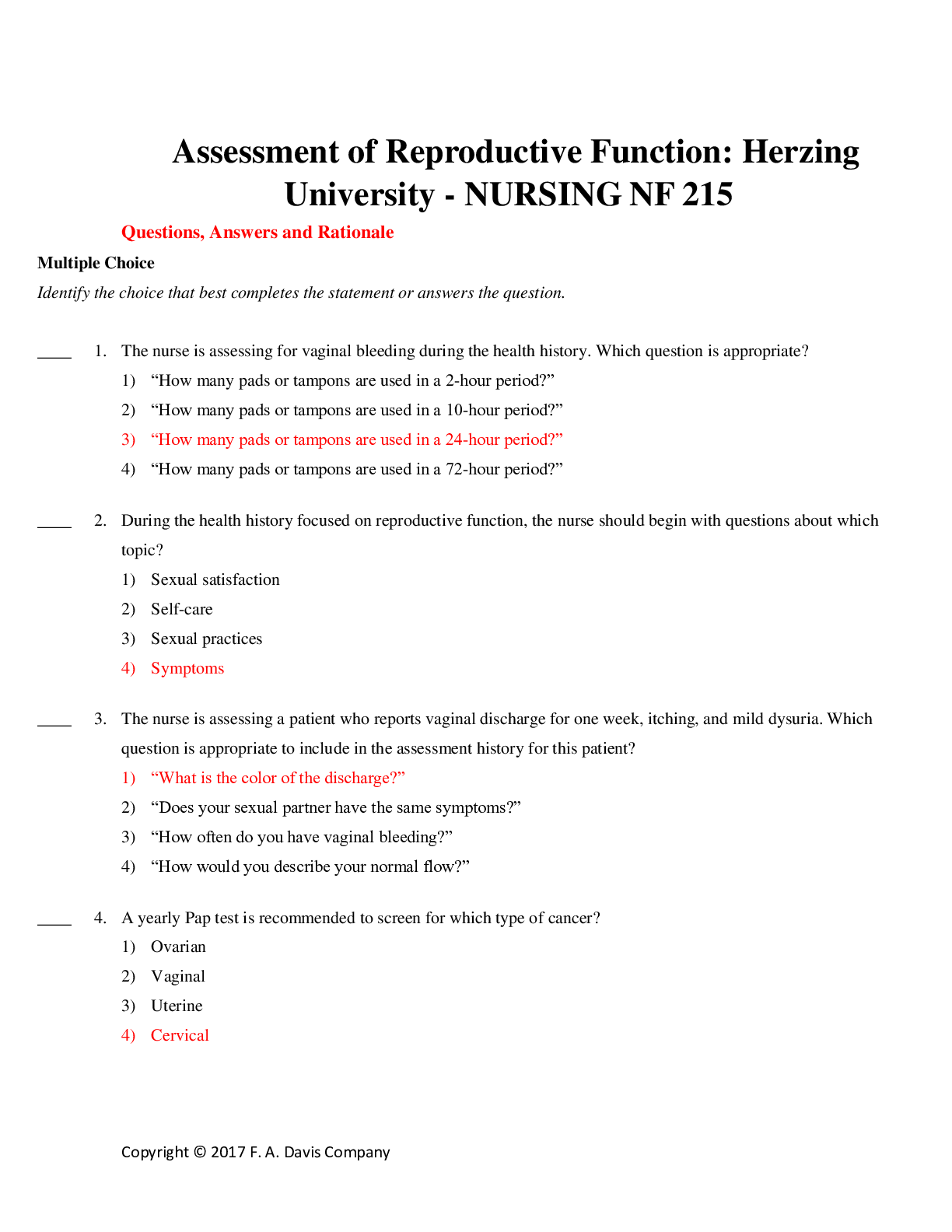

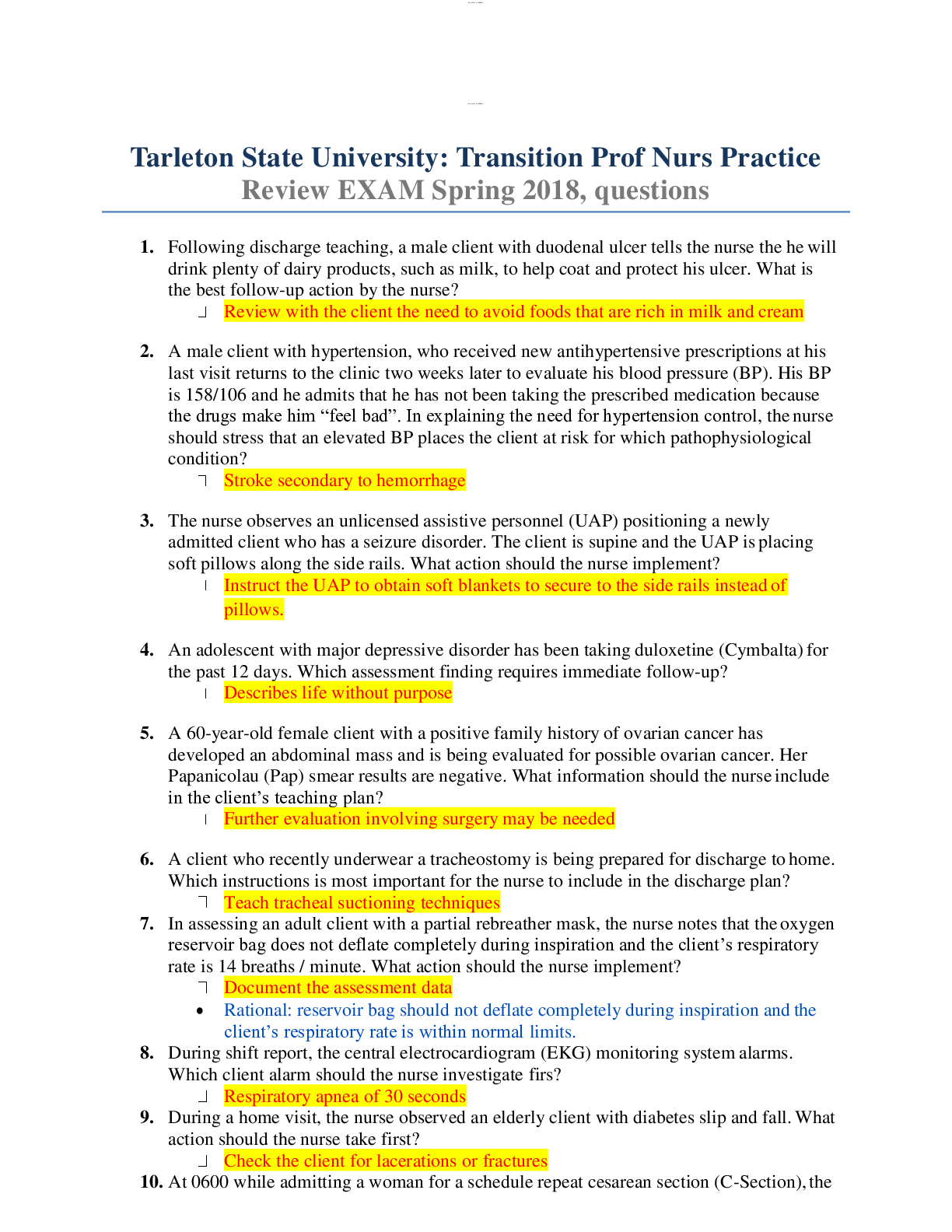
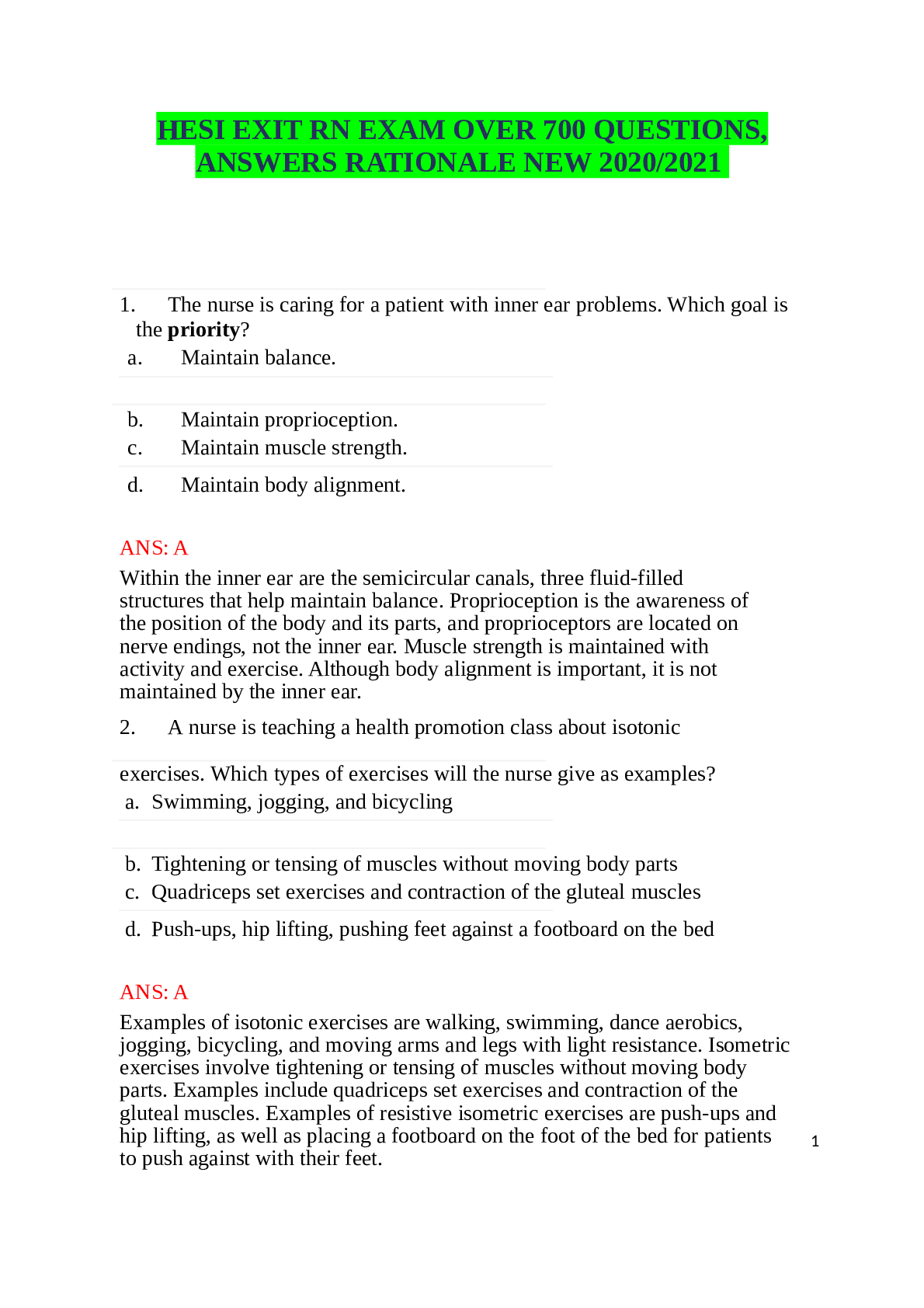

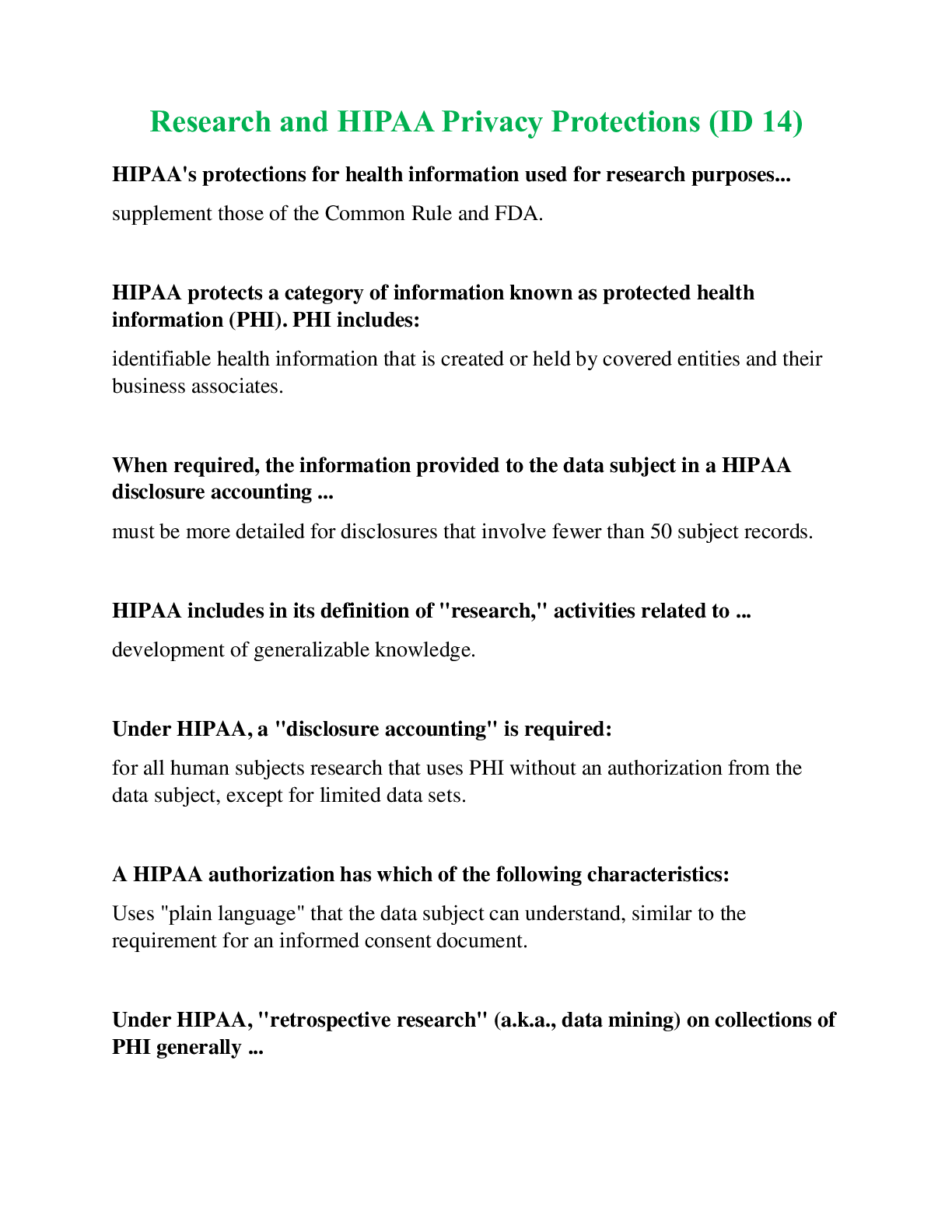
.png)
